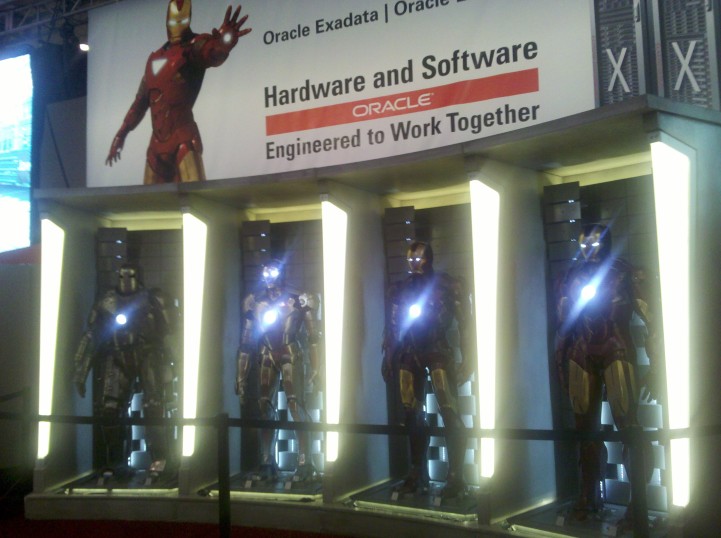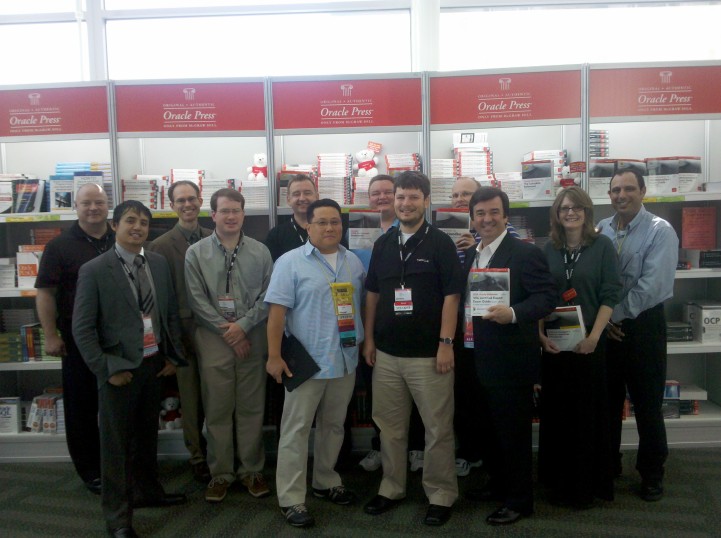Congratulations go out to tonight’s winner of the Chesapeake Regional Tech Council award for “Tech Company of the Year”: MedAssurant. It’s great to see a successful firm from my own home town of Bowie get proper recognition of their fantastic business, which has an active presence in virtually every county in the United States. Congrats in particular to its founder, Dr. Keith Dunleavy.
Meet the Authors event, Oracle Open World, 2010
Two of O’Hearn’s Books On Display At Oracle Open World 2010
Two of O’Hearn’s books on display at Oracle Open World 2010.
From September 22, 2010.

Advertising Post at Oracle Open World 2010
This advertising poster, on display at Oracle Open World 2010, announced the names of authors appearing at the book store within the conference for the various Meet the Author events.
From September 22, 2010.

Signing books at Oracle Open World 2010
Signing books at Oracle Open World 2010.
From September 22, 2010.

Oracle Open World – Meet the Authors
A couple of weeks ago I was in Dubrovnik, Croatia, and departed to attend the Oracle Open World conference in San Francisco, a rather long flight. While on the plane I got a chance to see the recent movie “Iron Man 2”, which features a cameo appearance by Larry Ellison. As I was sitting on the plane, somewhere over the Atlantic Ocean and bound for California, I thought “there you go, I’m sure we’ll hear about this at the Oracle conference.
Sure enough, as I walked into Hall D at the Moscone Center, here was the big display that remained for the entire conference just outside the keynote presentations:

And just up the escalator from the Iron Man display, Larry Ellison made sure we all got a chance to see the America’s Cup trophy he won back in February:

All very impressive. And the technical content was just as impressive.
I first started attending Oracle World conferences before they were called “Open World”, back when digit heads dominated the audience and most of the interest was in development tools. Today’s Oracle Corporation is much the same company with a dramatically broader and more comprehensive scope. Larry Ellison has dabbled in hardware in the past, and a couple of years ago Oracle began teaming with companies like HP to collaborate on some radical hardware architectures that achieved performance improvements in orders of magnitude greater than industry standards.
But thanks to their recent acquisition of Sun Microsystems, Oracle is in the hardware business in a more substantial manner than ever before.
All good database administrators know that data in RAM (Random Access Memory) processes much faster than data stored on a hard drive. Tuning a computer for performance has always included a step to review the management of RAM and hard drive storage of any database.
But in Oracle’s Exadata machines, they have taken the rather obvious step to increase RAM quite dramatically and eliminate the need for swapping information between the faster RAM and slower hard drives. I say “the rather obvious step”, but the fact is that nobody has done this before. It seems obvious in retrospect.
By building a machine with immensely large RAM – the latest Exadata machine revealed in September features two terabytes of RAM – Oracle has led the charge and increased benchmark speeds for database speed by orders of magnitude. It’s a brilliant move and one that has generated a rather healthy order backlog for their new Exadata machines.
The basic idea is to run the entire database in fast memory. It’s an obvious and brilliant move. Demand for the machines is huge and I’m sure will grow. As usual, Oracle is blazing a new trail that I’m sure industry will eventually follow.
While I was at the conference, on Wednesday, September 29, I participated in a Meet the Author event in the book store, a rather popular area at the conference. There I got a chance to meet and greet readers of Oracle Press books, and schmooze with other legendary Oracle Press / McGraw-Hill authors.

I’m in the picture above, third from the right.
This is definitely a great group of outstanding authors, a talented collection of Oracle professionals, and a fun and gracious group of people, I had a great time seeing old friends and colleagues and building new relationships.
Buzzword watch: Cloud Computing
I just read a post online by someone with a California police department who speaks of Google’s recent agreement with Los Angeles to bring in Google’s email platform to serve a local government office. This is described, in the post, as “cloud computing”.
Technically it is cloud computing. But this particular form of cloud computing is nothing new. Email online – through a web browser – has been around for years, since at least the mid-1990’s. The reason many people didn’t use webmail back in the early days was simple: you had to get web access to use it, and most people gained web access by paying a monthly fee to an Internet Service Provider, most of whom gave away email addresses with those monthly accounts. So who needed to also set up a free web-based account on Juno, or Hotmail?
I still remember when Microsoft acquired Hotmail in 1997, and web savvy pioneers lamented the impending doom of free browser-based email interfaces. Microsoft, the thinking went at the time, would bury Hotmail in exchange for pay-as-you-go services. Clearly that hasn’t happened.
Then there’s also the classic story about the time Microsoft didn’t pay their renewal fee to Network Solutions for a domain name associated with their implementation of Hotmail (the domain name was Passport.com), and the domain name registration expired, killing email access to a large portion of the 52 million Hotmail users. As the great behemoth of Microsoft engaged in troubleshooting, one lone technically sharp Hotmail customer named Michael Chaney figured it out and coughed up the $35 registration fee out of his own pocket with his personal credit card, reactivating Hotmail for the world. For his part in troubleshooting and repairing one of multi-billion-dollar tech giant’s flagship public products, Microsoft reimbursed Chaney with a check for $500, which he sold on ebay for much more.
BUT I DIGRESS … and that was all a long time ago.
The point is this: services such as Juno, Hotmail, and Google’s Gmail, have all been around in various forms and under various brand names for more than ten years.
They have all taken the complexity out of the problems of maintaining email servers and outsourced the management of email systems to other companies. None of them are new.
But cloud computing needs to be more than just the simple act of making software available through a browser, hosted offset by another company.
Cloud computing, by necessity, must offer comparable integration options, security, configuration, and other administrative features typically available to customers of hosted software.
In spite of the claims by even the leading vendors in the “cloud”, these capabilities are far from fully available. However, I’m sure it’s just a matter of time until the day comes when outsourced online enterprise services can be provided across the web in a fully customizable, fully integrated network of ad-hoc a la carte tools, all from a secure multi-tenant managed platform. That day is inevitable.
In the meantime, don’t be taken in by old webmail systems wrapped up in 2010 packaging with newer buzzwords. Online applications have been around for a long time. I still remember working with the World Bank to set up online loan management systems through a web interface as far back as 1995 and 1996. We didn’t call it a “cloud” at the time, but that’s what it was – easy-to-use point-and-click interfaces available to users worldwide who had no need to deploy hosted applications in their own office – we managed it for them, through an easy-to-use browser interface.
That was literally over ten years ago. The concepts are not new. But the buzzwords are.
That being said, a wider understanding of it is also new. And so are efforts to establish web-based – or should I say “cloud-based” – integration efforts through customizable screens. That is the real challenge in advancing the cause of cloud computing. Once that technological hurdle is overcome, we’ll start to see real advancements in the area of cloud computing.
We Don’t Need Farms Any More, We Have Grocery Stores Now
This morning’s tech journals are carrying reports that the U.S. federal government’s chief CIO Vivek Kundra has warned U.S. federal agencies to prepare for a “data deluge” as Web 2.0 applications ramp up in usage.
But this quote got my attention: at the July 21 Open Government and Innovations Conference, Kundra reportedly stated that “‘[t]his notion of thinking about data in a structured, relational database is dead” [1]. He added “”Some of the most valuable information is going to live in video, blogs and audio, and it is going to be unstructured inherently.”
It’s true that a certain portion of multimedia is inherently unstructured. But it’s not true that the relational database is “dead”, hardly. Aren’t all of those videos, blogs, and audio stored in Web 2.0 applications that themselves are all built on a relational database management platform?
Isn’t this sort of like saying “we don’t need farms any more, we have grocery stores now” – ? Well, where does the grocery store get its food from?
Where does the Web 2.0 application store its information? How are the videos, audio recordings, and blog entries – tracked, timestamped, and identified in terms of authorship, category, popularity, rating, relevance, keyword, etc.? How are user accounts managed? How is IP traffic tracked? How is billing controlled? How is data presented to an interface? Searched? Tracked? Protected? Backed up? How is all of the information about them organized and presented?
Answer: a relational database.
———————————————————————————-
Federal Computer Week, July 22, 2009, “Kundra to agencies: Get ready for deluge
IT Acquisition Reform
There’s a great article today at DefenseLink about the need for information technology acquisition reform on behalf of the DoD. The bottom line: current IT acquisition is patterned after conventional weapons systems acquisition in ways that suited large scale industrial manufacturing, but run counter to the nature of the speedy development, adoption, and enhancements of information technology.
It’s not new to make this observation about IT acquisition. What’s new is the interest on the part of the House Armed Services Committee (HASC) and the recognition by the White House that something drastic must be done quickly.
You can read the article online here.
Shock drowning at 47 years old: R.I.P. Rajeev Motwani
I just read that Rajeev Motwani was found dead Friday in the pool of his Palo Alto home. Very bizarre.
Motwani was the 47 year old Stanford professor who served as inspiration and advisor to many Silicon Valley success stories. Google co-founder Sergey Brin posted a reflection on Motwani on his blog on Friday.
Perhaps we’ll hear more as a complete report of the cause of his death becomes public.
But in the meantime, the moral I get out of this is: no matter how much fun your life might be, no matter what impact you may or may not have on the world … life is short.
Live well.
